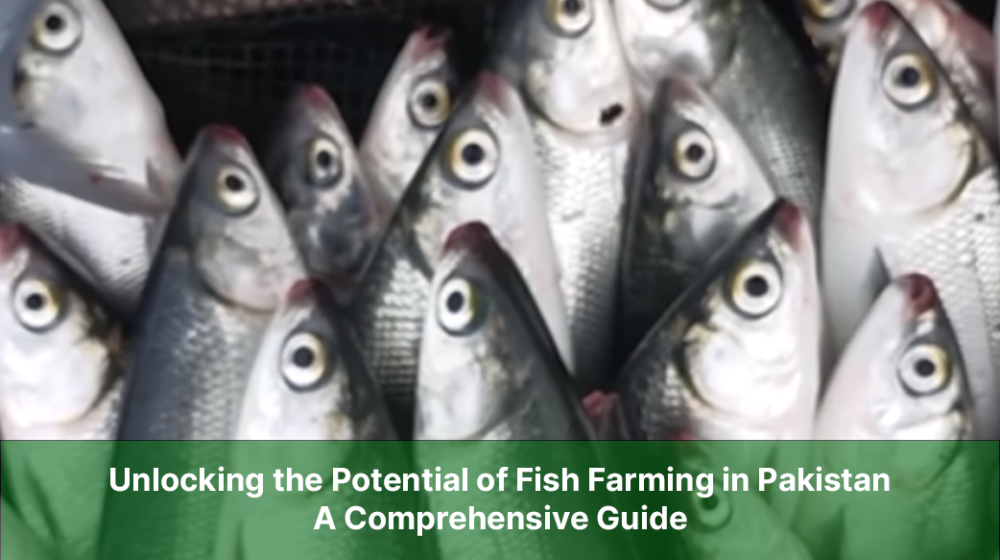Fish farming, also known as aquaculture, is a rapidly growing industry in Pakistan. With its vast coastline, rivers, and abundant water resources, Pakistan offers tremendous potential for both small-scale and commercial fish farming ventures. This article serves as a comprehensive guide for aspiring fish farmers, covering everything from starting on a small scale to implementing successful commercial farming practices, identifying the best fish breeds, marketing strategies, and accessing government loans for support.
- Getting Started with Fish Farming on a Small Scale
Starting fish farming on a small scale can be an excellent way to gain experience and gradually expand your operations. Here are the key steps to begin:
a. Site Selection: Choose a suitable location with access to freshwater sources, adequate land space, and favorable environmental conditions.
b. Selecting Fish Species: Consider popular freshwater fish breeds in Pakistan, such as tilapia, carp (rohu, catla, and mrigal), and trout. Research their specific requirements and profitability.
c. Constructing Ponds/Tanks: Build or dig ponds or tanks based on the chosen fish species, ensuring proper drainage and water management.
d. Water Quality Management: Monitor and maintain optimal water quality parameters including temperature, oxygen levels, pH, and ammonia concentration.
e. Feeding and Nutrition: Provide balanced and nutritious feed to your fish, considering their specific dietary needs and growth stages.
f. Disease Management: Implement preventive measures to control diseases through regular health checks, proper sanitation, and vaccination.
- Scaling Up to Commercial Fish Farming
Once you have gained experience and want to expand your fish farming operations, transitioning to commercial farming is the next step. Here’s how to do it effectively:
a. Business Planning: Develop a detailed business plan that encompasses market analysis, investment requirements, production targets, and financial projections.
b. Infrastructure and Equipment: Upgrade or expand your infrastructure, including ponds, tanks, water supply systems, aeration systems, and feeding equipment, to support larger-scale production.
c. Staffing and Training: Hire skilled labor, if needed, and provide appropriate training to ensure efficient farm operations.
d. Value-Added Products: Explore opportunities for value addition, such as fish processing, packaging, and freezing, to diversify your product range and increase profitability.
e. Market Research: Identify potential markets and target consumers for your fish products. Analyze demand, pricing trends, and competition to make informed marketing decisions.
- Selecting the Best Fish Breeds for Farming
Choosing the right fish breed is crucial for successful fish farming. Consider the following factors when selecting a breed:
a. Adaptability: Opt for fish species that can thrive in local environmental conditions, such as temperature, water quality, and disease resistance.
b. Market Demand: Research the market demand for different fish species and identify breeds that have high consumer preference and profitability.
c. Growth Rate: Select fish breeds that exhibit rapid growth and efficient feed conversion, ensuring faster time-to-market and higher profitability.
d. Feeding Habits: Consider the feeding habits of the fish species to ensure the availability of appropriate feed and reduce operational costs.
- Effective Marketing Strategies for Fish Farming
Implementing effective marketing strategies is vital for the success of your fish farming business. Consider the following approaches:
a. Branding and Packaging: Develop a distinct brand identity and invest in quality packaging to attract consumers and differentiate your products in the market.
b. Local and Regional Markets: Establish direct relationships with local fish markets, retailers, hotels, restaurants, and supermarkets to secure consistent sales channels.
c. Online Presence: Leverage the power of digital platforms by creating a website, engaging in social media marketing, and listing your products on e-commerce platforms.
d. Consumer Education: Educate consumers about the nutritional benefits and quality of farmed fish through awareness campaigns, cooking demonstrations, and recipe sharing.
- Government Loans for Fish Farming in Pakistan
The government of Pakistan recognizes the potential of fish farming and offers financial support through various schemes and programs. Here’s how you can access government loans:
a. Research: Explore government-sponsored loan programs for the agriculture and fisheries sectors, such as the Agricultural Development Bank of Pakistan (ADBP) and the Pakistan Agricultural Loan Scheme (PALS).
b. Eligibility Criteria: Familiarize yourself with the eligibility criteria, documentation requirements, and application procedures for the relevant loan schemes.
c. Business Plan and Documentation: Prepare a comprehensive business plan, financial projections, and other necessary documents required for loan applications.
d. Application Submission: Submit your loan application along with the required documents to the designated government authorities or financial institutions.
e. Follow-up and Compliance: Maintain regular communication with the concerned authorities, adhere to the loan terms, and fulfill reporting and repayment obligations.
Fish farming presents an excellent opportunity for individuals and entrepreneurs in Pakistan to contribute to the country’s food security and generate sustainable income. By starting on a small scale, aspiring fish farmers can gain experience and gradually transition into commercial farming, identifying the best fish breeds and implementing effective marketing strategies. With the government’s support through loan programs, the journey toward establishing a successful fish farming business becomes more achievable. Embrace the immense potential of fish farming and embark on this rewarding venture today.
